 Features
Features

The 11th century Vinh Nghiem Pagoda and its collection of 3,050 rare Han-Nom woodblocks are just two of a plethora of attractions that await tourists visiting Bac Giang Province. Bui Quynh Hoa reports.
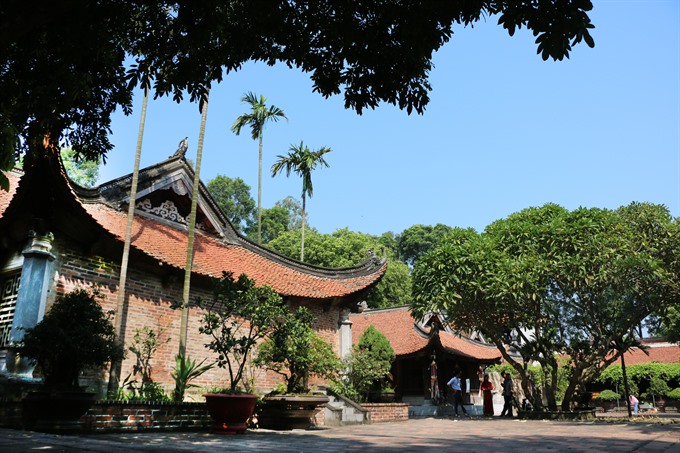 |
| Religious centre: Vĩnh Nghiêm Pagoda is known as a centre for Buddhism in the northern province of Bắc Giang. VNS Photo Đoàn Tùng |
The 11th century Vinh Nghiem Pagoda and its collection of 3,050 rare Han-Nom woodblocks are just two of a plethora of attractions that await tourists visiting Bac Giang Province. Bui Quynh Hoa reports.
Taking a stroll in the ancient and peaceful Vĩnh Nghiêm Pagoda, known as a centre for Buddhism in the northern province of Bắc Giang, is a special experience that everyone should try, especially in the charming time of autumn.
Vĩnh Nghiêm Pagoda was built in the Lý Dynasty in the 11th century under the reign of King Lý Thái Tổ (1010-1028) in the village of Đức La, Trị Yên Commune, Yên Dũng District, about 80km from Hà Nội.
“Initially named Chúc Thánh, the pagoda later took the name of the village and was called La Pagoda or Đức La Pagoda,” said Lê Thị Khơi, from the Relics Management Board of Yên Dũng District.
“The pagoda was embellished, expanded, and renamed Vĩnh Nghiêm under the reign of Trần Nhân Tông (1278-1293). Vĩnh Nghiêm means Forever Lasting and Solemn,” Khơi added.
It was where the three first patriarchs of Trúc Lâm Zen Buddhism: Trần Nhân Tông (1258-1308), Pháp Loa (1284-1330) and Huyền Quang (1254-1334) once preached and it served as a training institution for monks during the Trần Dynasty (13th-14th centuries).
The pagoda is considered the first Buddhism university of Việt Nam, and the place of origin for Trúc Lâm Zen Buddhism, playing an important role in the history of Buddhism in Việt Nam general and in the Trần Dynasty in particular.
Special woodblocks
Coming to Vĩnh Nghiêm, you can’t help talking about the valuable woodblocks here.
The collection of 3,050 woodblocks with about 2,000 Han-Nôm characters, most of which are Buddhist texts, sutras, the writings of the three first patriarchs and some by other master monks of Trúc Lâm Zen Buddhism. The pagoda also stores some texts on treatments with medicinal herbs and acupuncture.
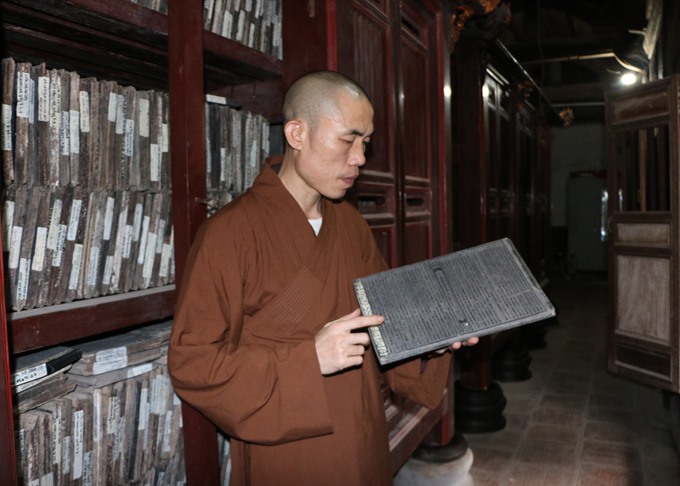 |
| Keeping a check: The Venerable Thích Thanh Vịnh checks the woodblocks that have been recognised by UNESCO as World Documentary Heritage items as part of the Memory of the World Programme, to make sure they are preserved well. VNS Photo Đoàn Tùng |
According to the Venerable Thích Thanh Vịnh, vice head of Vĩnh Nghiêm Pagoda, the woodblocks here were made by artisans of the craft villages in Bắc Giang and Bắc Ninh provinces, and especially Hải Dương Province’s Liễu Tràng Craft Village, which specialises in engraving woodblocks.
The majority of the blocks feature printing on both sides and have been engraved with Han and Nôm characters in a mirror like fashion. The depth of the engravings is approximately 1-1.5mm, so the prints on dó (poonah) paper are very clear.
“The size of the woodblock depends on the category of the sutra. The biggest block is over 100cm in length and 40-50cm in width. The smallest one is only 15x20cm.
“The woodblocks not only consist of the deep thoughts and values of Trúc Lâm Zen, but also serve as remarkable calligraphic and artistic items, and mark the development of the Vietnamese Nôm ideographic script in different periods of time.
“These are also excellent works of art with unique, original and irreplaceable features. Through this collection, readers can discover plentiful information about many fields such as religion, language, literature, medicine and art,” he said.
On May 16, 2012, at a meeting of the Asia Pacific Regional Committee of UNESCO held in Bangkok, Thailand, the Buddhist Sutra Woodblocks of Trúc Lâm Zen at Vĩnh Nghiêm Pagoda were on the lists of World Documentary Heritage as part of the Memory of the World Programme. Their acceptance was based on the three criteria of authenticity; uniqueness and irreplaceability; and their position and role in the region.
Veteran monk Thích Thanh Vịnh, vice head of Vĩnh Nghiêm Pagoda said: "The woodblocks are now in good condition although they have been kept at fairly simple facilities for many years.
"The blocks are checked by monks at the pagoda four times a year. Because both sides of the blocks are carved with characters, the checks should be made carefully," he added. "That’s why they have been well preserved despite harsh weather and war.”
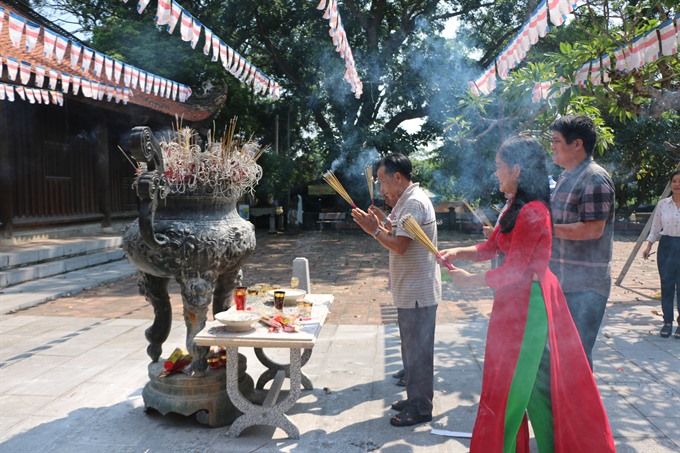 |
| Becoming popular: More and more visitors and researchers are visiting the land of Trúc Lâm Zen Buddhism. VNS Photo Đoàn Tùng |
Vĩnh Nghiêm Pagoda was recognised as a national historical and cultural site in 1964. Its festival, which is held annually from the 12th to 14th day of the second lunar month, was also recognised as a national intangible cultural heritage site in 2013. Significantly, the pagoda was recognised as a special national relic in 2015.
Addressing the certificate awarding ceremony, Prime Minister Nguyễn Xuân Phúc stressed that the locality should develop a plan to preserve Vĩnh Nghiêm Pagoda soon.
The PM asked the province to broadcast widely the cultural, historic, scientific and aesthetic values of the pagoda, so that it would become an attractive destination for tourists.
He also proposed that Bắc Giang Province should implement further studies on its value in connection with the Complex of Yên Tử Monuments and Landscapes, which should be referred to UNESCO as a World Heritage site.
The UNESCO Chief Representative to Việt Nam, Katherine Muller-Marin, also highly appreciated the pagoda and its valuable woodblocks.
“On behalf of UNESCO, I congratulate you on your efforts to preserve this beautiful pagoda and to care for the woodblocks that represent the memory of an important part of world history,” said Muller-Marin.
“I believe this pagoda is one of the most beautiful pagodas I have visited. You can feel the rich history and the spirituality. I wish you success in your work to protect and conserve the woodblocks and in your teachings to the people,” she added.
Thanks to the recognition, the number of visitors coming to Vĩnh Nghiêm Pagoda has increased rapidly, from 82,000 visits in 2013 to 144,000 in the first eight months of this year, according to the Relic Management Board of the province’s Yên Dũng District.
“This is the first time I have come to Vĩnh Nghiêm Pagoda,” said Hoàng Thị Thơ from Tuyên Quang Province. “It’s really ancient, beautiful and peaceful.”
Trương Thị Huệ from Quảng Trị Province agreed with Thơ.
“Vĩnh Nghiêm Pagoda’s architecture is very old. I feel its sacred nature, but also relaxed and calm in my soul when I am here. It’s one of the most beautiful pagodas in Bắc Giang I have come to.”
Tourism potential
“Bắc Giang Province is home to more than 101 national and special national relic sites like Vĩnh Nghiêm Pagoda, the Hoàng Hoa Thám Relic Site, and the Yên Thế uprising zone complex which includes 23 relics in the four districts of Yên Thế, Tân Yên, Việt Yên and Yên Dũng,” said Nguyễn Phúc Thương, vice director of Bắc Giang’s Department of Culture, Sport and Tourism.
“The province is also endowed with various scenic sites, notably Bổ Đà Pagoda, Suối Mỡ and Đồng Thông tourism areas, Cấm Sơn Lake and the Khe Rỗ primitive forest.”
According to Thương, Bắc Giang is also one of the provinces that hold the greatest number of annual festivals. It is estimated that the province has about 540 traditional festivals, which are held in the first three lunar months of the year. Many of them feature the unique cultural identities of local ethnic minority groups.
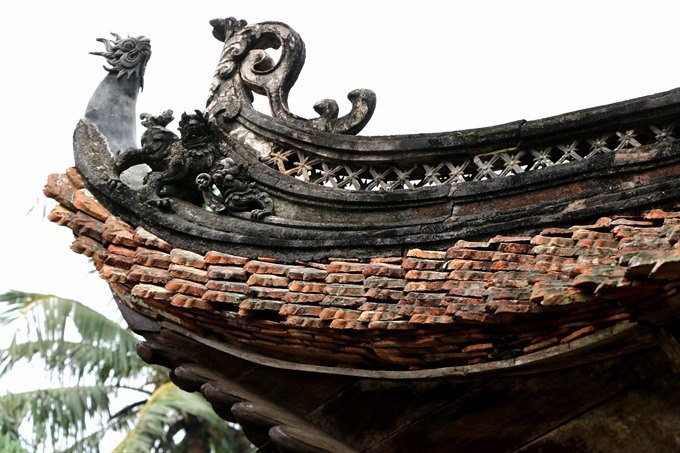 |
| Classic style: The ancient architecture of the pagoda is highly recommended for researchers. VNS photo Đoàn Tùng |
In addition, a variety of its specialties have long been famous throughout the country, such as lychees grown in Lục Ngạn District, the rice wine of Vân Village, the ceramics of Thổ Hà, the crispy rice crackers of Kế Village, rice noodles of Nam Dương Village, and bee honey from Sơn Động Village.
“Realising our great potential for tourism, we have mapped out plans to maximally exploit and develop our tourism products, especially on spiritual culture, history and ecological relaxation,” said Thương.
With the target of turning tourism into one of its important economic sectors, Bắc Giang has exerted efforts in implementing a number of programmes and projects to expand the industry in the coming decades.
“Thanks to the efforts, the number of tourists coming to our province has increased considerably, from 160,000 visits in 2011 to nearly 410,000 in 2015,” said Lê Ánh Dương, vice chairman of the Bắc Giang People’s Committee.
“The average rate of increase in the 2011-15 period was 23.4 per cent. We plan to reach more than one million visits by 2020, with an average rate of increase of 25 per cent in the period 2016-20,” Dương said.
"Co-operation among neighbouring provinces to develop tourism, especially spiritual tourism, was essential.
“It’s feasible for Bắc Giang to co-operate with Hà Nội and other provinces including Quảng Ninh, Lạng Sơn, Hải Dương, Hải Phòng, Thái Nguyên and even HCM City to develop our own tourism products and promote attractive tours.” VNS
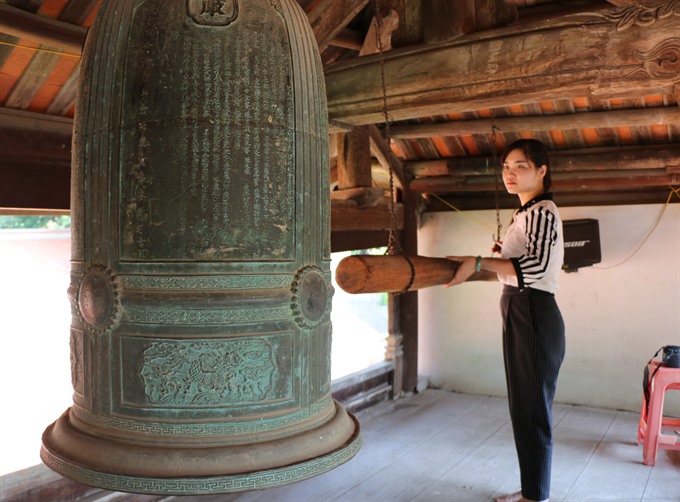 |
| Ancient bell: The bell tower is one of four ancient art works remaining at the pagoda. VNS photo Đoàn Tùng |




